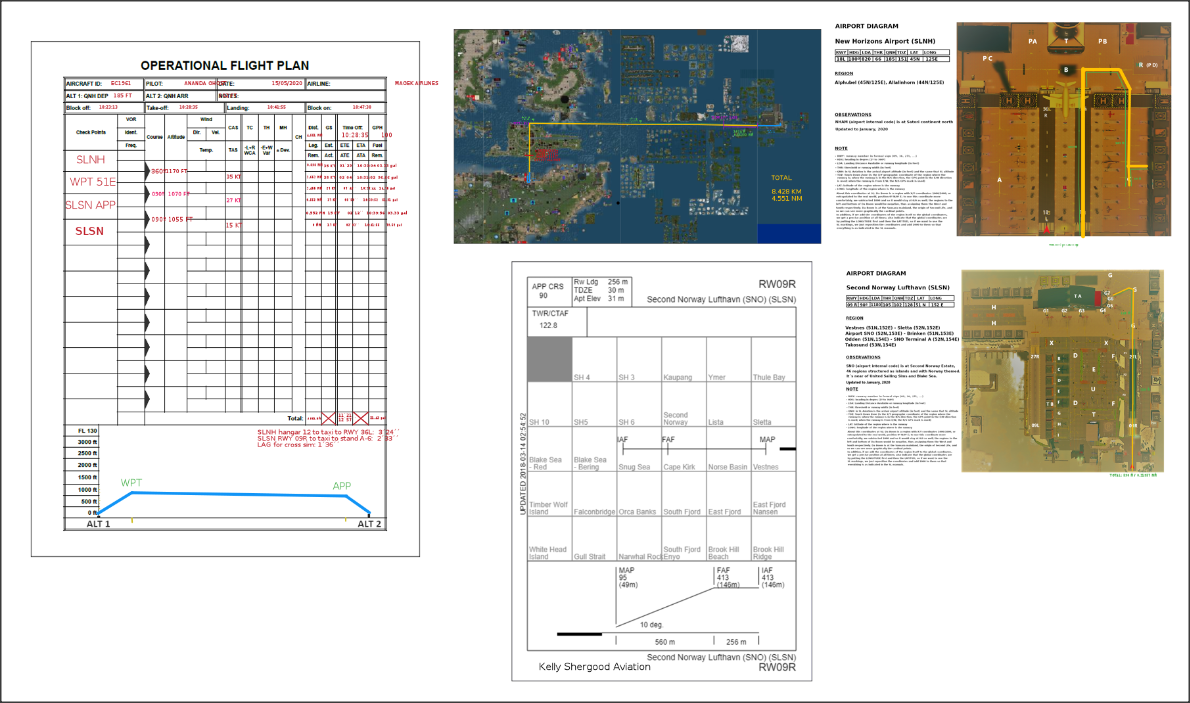RULES FOR COMPLETING AN OPERATIONAL FLIGHT PLAN
What is the OPERATIONAL FLIGHT PLAN or OFP?
Basically we can say that it is the planning of a route to follow, from one airport to another, taking into account all the steps to follow although putting all the information in writing, both the distances of the route, the time it takes, the altitude to which it will go, as well as several factors that have to be taken into account.
In real life, those responsible for collecting all the work of information on routes, airport data, meteorology, as well as calculations of appropriate speeds, distances, waypoints and record all documentation (Operational Flight Plan and ATC Flight Plan), as well as sending it to both the Air Traffic department and the pilots of the aircraft are known as Flight Dispatchers , each company having several technicians, responsible for both flight planning and ground and during flight control; of course, being a tedious and repetitive job, powerful computer programs and computers are used that collect all the information and give a specific flight plan for each situation; this is basically used for airlines with IFR flights, but in the case of private IFR flights or local VFR flights, dispatchers are usually private technicians or even the same pilots, as the information is not as bulky as for a commercial flight.
OFP applied to Second Life
There are many of the data that will not be taken into account, such as weather, as we do not have wind, atmospheric pressure or temperature affecting the aircraft, as well as no magnetic fields that de-either the route, so we will focus on the distances between airports and intersection points (waypoints or checkpoints), speeds (take-off, cruise and landing) and times (from start-up, pushback, taxi, holding point, line up, take-off, cruise, landing, taxi and parking at the indicated stand).
Finally, if we have an aircraft that has a fuel simulation, we can calculate the virtual gallons it consumes per hour and what the plane consumes in each stretch of time (the Phenom 100 has a fuel simulator that refueled to 100% gives us an hour of autonomy), considering that when the fuel runs out the plane collapses (it gives us warnings from time to time , but it is convenient to calculate the times to have a "fuel" reserve in case of need).
As an anecdotal data, indicate that on the last flights performed to which it applied this system, while towards the calculations of flight time between airports, I discovered that there was a lag of a few minutes more than what was calculated; checking the videos and timestamps when crossing the regions, I could see that there were regions where the plane took a minimum of three seconds (and sometimes up to ten seconds), so I had to use an average coefficient of seven seconds per cross region to give a similar or slightly higher amount in a few seconds to the initial result; the form takes into account something similar for a real flight (say that it is not a closed form, such as the flight plan, but that there is data that is added during the flight or at the end of the flight when reviewing the FDR or Flight Data Recorder where you can see the time of crossing region).
Small explanation of the acronyms or items found in the form
- AIRCRAFT ID: aircraft indication (N23CH, EC1961)
- PILOT: pilot's name
- DATE: the date of the flight in collapsed format (May 10, 2020 - 10052020)
- AIRLINE: airline name, if you have
- ALT 1: QNH DEP: altitude in feet of the departure airport.
- ALT 2: QNH ARR: the altitude in feet of the arrival airport
- NOTES: you can indicate the flight number (MAG13, IBE235, AA67), or some other data.
- Block off: (STARTUP) UTC or ZULU time to remove chocks from the plane at your stand or parking, once the engine ignition started and getting ready to make pushback and taxi
- Take-off: UTC or ZULU take-off time
- Landing: UTC or ZULU landing time
- Block on: (SHUTDOWN) UTC or ZULU time of staging of the aircraft's chocks in your stand or parking, once the engines are turned off and already located in the stand to disembark
- Check Points: the names of airports (departure and arrival), radio help and intersection points of the route to be followed indicated in ICAO code, GPS marking, waypoint name or region name.
- VOR: is a Very High Frequency Omnidirectional Radiofare, being a radio broadcast that helps in air navigation to indicate a precise geographical point.
- Ident.: name of the VOR
- Freq.: Frequency at which it transmits the VOR
- Course: flight direction indicated in degrees, from 000o to 359o
- Altitude: in our case, the altitude indicated in Second Life as absolute, indicated in feet or flight level if the height is greater than 1000 feet.
- Wind: winds indicated in the METAR and other weather services, not applied in SL.
- Dir.: direction of the wind indicated in degrees, not applied in SL.
- Vel.: wind speed indicated in knots, not applied in SL.
- Temp.: temperature indicated in degrees Celcius (C) or Fahrenheit (F), as indicated for each altitude, not applied in SL.
- CAS: Calibrated Air Speed, not applied in SL.
- TAS: True Air Speed, for THE purposes of SL is the same as the ground speed, indicating itself in knots.
- TC: True Course, magnetic heading not applied in SL.
- TH: True Heading, magnetic heading not applied in SL.
- MH: Magnetic Heading, magnetic bearing not applied in SL.
- WCA: Wind Correction Angle, not applied in SL.
- Var: Magnetic Variation, not applied in SL.
- Dev: Magnetic Deviation Angle, not applied in SL.
- CH: Compass Heading, not applied in SL.
- Dist.: total distance between airports, including waypoints, indicated in nautical miles.
- Leg.: distance traveled in a given section (Leg1, Leg2, Leg3,...)
- Rem.: remaining distance, obtained by subtracting the total distance of the traveled (Rem1=Leg1-Dist) the first time, being then the calculation of the subtraction of the distance traveled in the next section of the total remaining distance (Rem2=Leg1-Rem1), etc.
- GS: Ground Speed.
- Est.: Estimated speed, or calculated through typical takeoff, cruise or landing speeds; for example I use on the ascent 38 knots, on cruise 27 and on descent 20.
- Act: Current speed, is the one that is actually carried in each leg, indicated for reference purposes for future flight performance corrections.
- Time Off: takeoff time, must be indicated under this item. Indicate that the following calculations are adapted to the particular characteristics of SL.
- ETE: Estimated Time of Enroute, is the estimated duration time of the run performed and is calculated by performing the formula of time (t=d/v).
- ETA: Estimated Time of Arrival, is the estimated time of arrival and is obtained by adding the times obtained with the ETE, and then add them to the Time Off. Indicate that ETE and ETA are calculated times without adding region crossing delays.
- ATE: Current Time Enroute, is the time we take in real time for each leg or waypoint made, and is where you can see the seconds or minutes of more that need to be added, due to the region crossings.
- ATA: Current Time of Arrival, is the actual arrival time, obtaining with the subtraction of the ETE to the ATE, amount that is then added to ETA, this being the corrected time that will help us in the final calculations in the approximation and in the calculation of remaining fuel that we must take by precaution.
- GPH: Gallons per Hour, are the gallons consumed in an hour by our plane; those who have fuel simulation, once refueled, should mark 100% (for our purposes 100 gallons in the wing tank) and indicate that the autonomy is one hour; so we put under GPH 100.
- Fuel: is the fuel consumed per section or waypoint (the calculation is obtained by subtracting from 100 the amount in percentage indicated by the aircraft (e.g. 100-87= 13 gallons consumed)
- Rem.: Remnant, or the fuel left in the tank; you can see directly seeing what is indicated in percentage marked by the aircraft (in the example above would be 87 gallons). On flights longer than one hour we must refuel in advance, setting in our flight plan the refueling stops and airports available with pumps adapted to our type of aircraft. The minimum gallon mark should be over fifteen gallons to avoid falling short and having an accident, or the plane standing in the middle of the runway.
- Note regarding fuel: I don't know other types of aircraft, but the Phenom 100's fuel simulator does not discriminate against a stopped or moving aircraft, just as long as the engines are on, so I advise performing start-up, pushback and taxi maneuvers as quickly as possible; likewise, if the servers are ok and a speed greater than 30 knots is allowed without having problems, it would be nice to consider a higher cruising speed to save fuel (on a personal level I have tried but I always have accidents, I imagine that because of the weight in scripts that I carry, although I have reduced them to the minimum)
- At the bottom, we find the word "Total", where we will put the totals of partial distances (Leg), part-time (ETE) and fuel consumed (Fuel).
- Finally, below on the left, we have a space reserved to make a vertical graph of our flight, being indicated in the boxes various altitudes (adapted to Second Life) being marked from 0 feet at flight level 130 0 13000 feet, the maximum height in Second Life, close to 4000 meters, limit to be able to use physical objects (although not to continue flying as Superman , for which there are no limits). In ALT 1 we will put the name and altitude of the departure airport, in the horizontal section we will put the waypoints through which we will pass (approximately) and in ALT 2 the name and altitude of the arrival airport; then, in the column of altitudes, we will mark with a point the altitude for each section, finally joining the points which gives us a visual graph of our flight and its sections.
Example of a recent flight and how to fill out the form
It is not usual in real life to fill out this form indicating in the box of the routes to follow the sections of TAXI (time and fuel consumed from departure or arrival at the stand) both at the departure and arrival airport, but for the purpose of taking into account for future calculations of the same route and equal conditions , will prevent us from re-performing the whole process.
The example route is from New Horizons Airport to Second Norway Airport, departing from my hangar and parking in one of the medium and light aircraft stands in Terminal A. 100% fuel tanks (100 gallons). Autonomy of one hour of flight, without considering the reservation. The route is direct, with a single waypoint, being the distance of almost four nautical miles (perhaps a little more). Let's look at the following drawing (the PDF file is the same in high quality):


